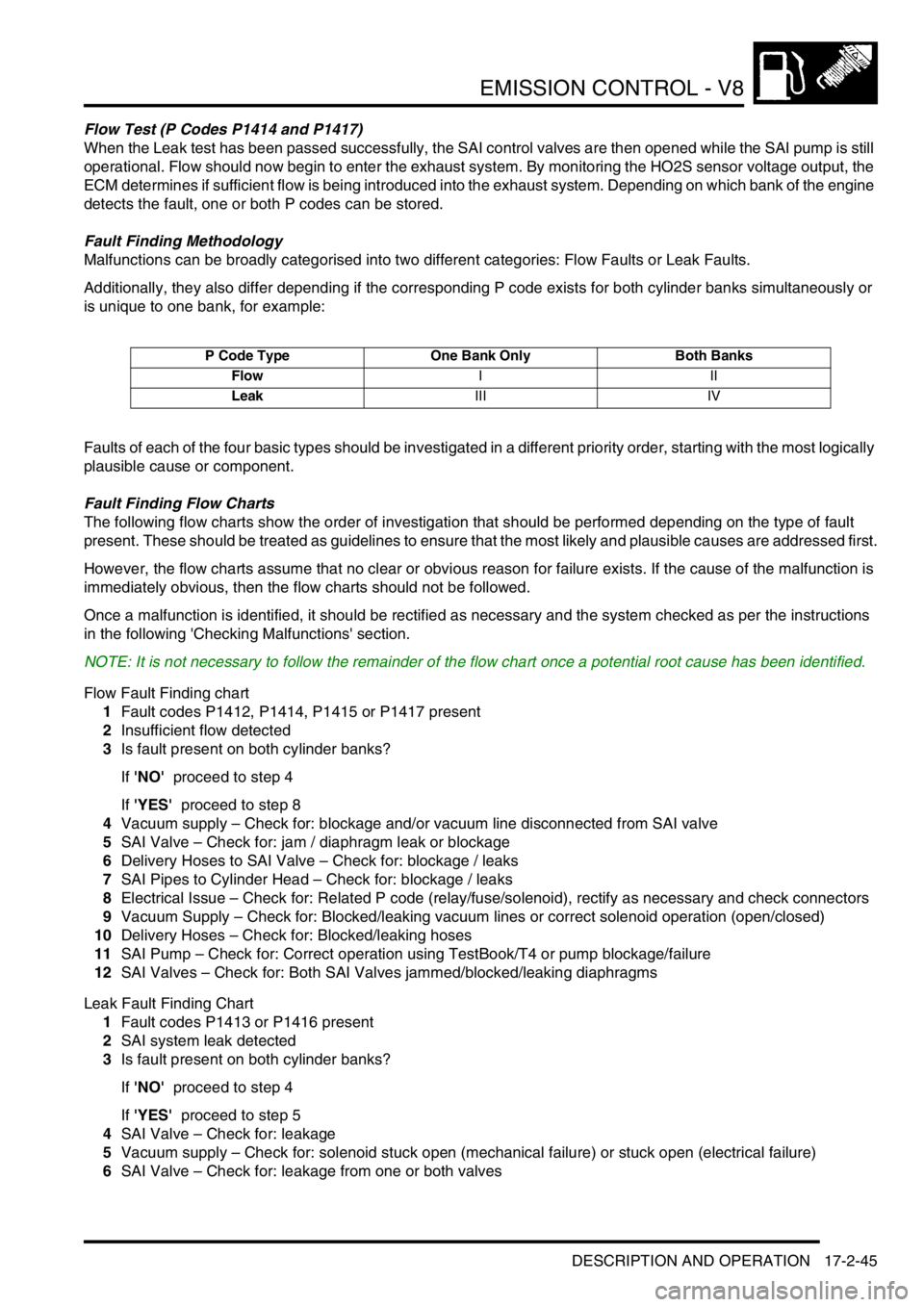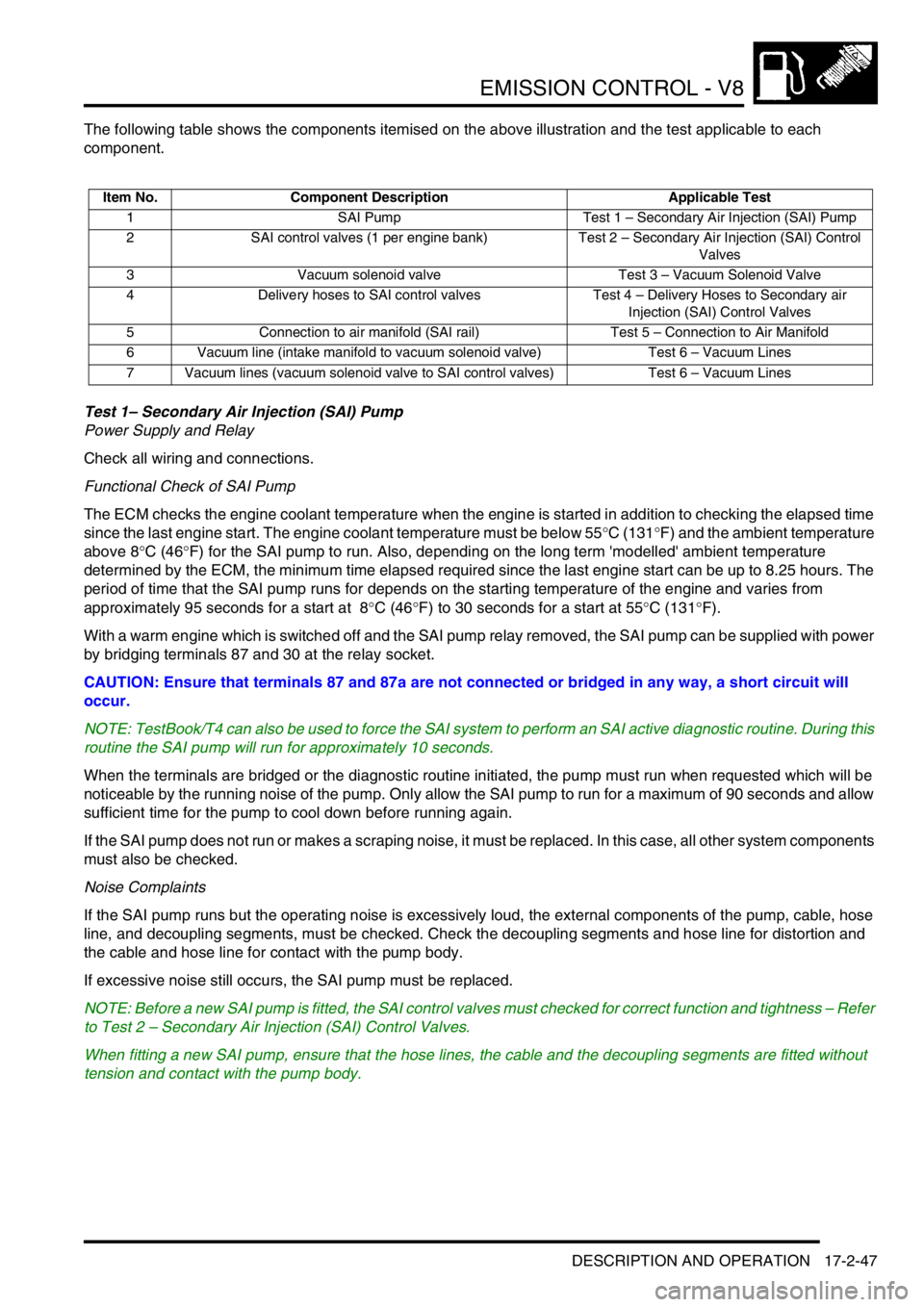LAND ROVER DISCOVERY 1999 Workshop Manual
Manufacturer: LAND ROVER, Model Year: 1999, Model line: DISCOVERY, Model: LAND ROVER DISCOVERY 1999Pages: 1529, PDF Size: 34.8 MB
Page 271 of 1529

EMISSION CONTROL - V8
17-2-38 DESCRIPTION AND OPERATION
Mass Air Flow (MAF) Sensor and Air Temperature Sensor
The engine management ECM uses the mass air flow sensor to measure the mass of air entering the intake and
interprets the data to determine the precise fuel quantity which needs to be injected to maintain the stoichiometric
air:fuel ratio for the exhaust catalysts. If the mass air flow sensor fails, lambda control and idle speed control will be
affected and the emission levels will not be maintained at the optimum level. If the device should fail and the ECM
detects a fault, it invokes a software backup strategy.
+ ENGINE MANAGEMENT SYSTEM - V8, DESCRIPTION AND OPERATION, Description - engine
management.
The air temperature sensor is used by the engine management ECM to monitor the temperature of the inlet air. If the
device fails, catalyst monitoring will be affected. The air temperature sensor in integral to the mass air flow sensor.
+ ENGINE MANAGEMENT SYSTEM - V8, DESCRIPTION AND OPERATION, Description - engine
management.
Throttle Position Sensor
If the engine management ECM detects a throttle position sensor failure, it may indicate a blocked or restricted air
intake filter. Failure symptoms may include:
lPoor engine running and throttle response
lEmission control failure
lNo closed loop idle speed control
lAltitude adaption is incorrect
If a signal failure should occur, a default value is derived using data from the engine load and speed.
+ ENGINE MANAGEMENT SYSTEM - V8, DESCRIPTION AND OPERATION, Description - engine
management.
Atmospheric pressure will vary with altitude and have a resulting influence on the calculations performed by the ECM
in determining the optimum engine operating conditions to minimise emissions. The following are approximate
atmospheric pressures for the corresponding altitudes:
l0.96 bar at sea level
l0.70 bar at 2,750 m (9,000 ft.)
Page 272 of 1529

EMISSION CONTROL - V8
DESCRIPTION AND OPERATION 17-2-39
Evaporative Emission Control Operation
Fuel vapour is stored in the activated charcoal (EVAP) canister for retention when the vehicle is not operating. When
the vehicle is operating, fuel vapour is drawn from the canister into the engine via a purge control valve. The vapour
is then delivered to the intake plenum chamber to be supplied to the engine cylinders where it is burned in the
combustion process.
During fuel filling the fuel vapour displaced from the fuel tank is allowed to escape to atmosphere, valves within the
fuel filler prevent any vapour escaping through to the EVAP canister as this can adversely affect the fuel cut-off height.
Only fuel vapour generated whilst driving is prevented from escaping to atmosphere by absorption into the charcoal
canister. The fuel filler shuts off to leave the tank approximately 10% empty to ensure the ROVs are always above
the fuel level and so vapour can escape to the EVAP canister and the tank can breathe. The back pressures normally
generated during fuel filling are too low to open the pressure relief valve, but vapour pressures accumulated during
driving are higher and can open the pressure relief valve. Should the vehicle be overturned, the ROVs shut off to
prevent any fuel spillage.
Fuel vapour generated from within the fuel tank as the fuel heats up is stored in the tank until the pressure exceeds
the operating pressure of the two-way valve. When the two-way valve opens, the fuel vapour passes along the vent
line from the fuel tank (via the fuel tank vapour separator) to the evaporation inlet port of the EVAP canister. The fuel
tank vents between 5.17 and 6.9 kPa.
Fuel vapour evaporating from the fuel tank is routed to the EVAP canister through the fuel vapour separator and vent
line. Liquid fuel must not be allowed to contaminate the charcoal in the EVAP canister. To prevent this, the fuel vapour
separator fitted to the fuel neck allows fuel to drain back into the tank. As the fuel vapour cools, it condenses and is
allowed to flow back into the fuel tank from the vent line by way of the two-way valve.
The EVAP canister contains charcoal which absorbs and stores fuel vapour from the fuel tank while the engine is not
running. When the canister is not being purged, the fuel vapour remains in the canister and clean air exits the canister
via the air inlet port.
The engine management ECM controls the electrical output signal to the purge valve. The system will not work
properly if there is leakage or clogging within the system or if the purge valve cannot be controlled.
+ ENGINE MANAGEMENT SYSTEM - V8, DESCRIPTION AND OPERATION, Description - engine
management.
When the engine is running, the ECM decides when conditions are correct for vapour to be purged from the EVAP
canister and opens the canister purge valve. This connects a manifold vacuum line to the canister and fuel vapour
containing the hydrocarbons is drawn from the canister's charcoal element to be burned in the engine. Clean air is
drawn into the canister through the atmosphere vent port to fill the displaced volume of vapour.
The purge valve remains closed below preset coolant and engine speed values to protect the engine tune and
catalytic converter performance. If the EVAP canister was purged during cold running or at idling speed, the additional
enrichment in the fuel mixture would delay the catalytic converter light off time and cause erratic idle. When the purge
valve is opened, fuel vapour from the EVAP canister is drawn into the plenum chamber downside of the throttle
housing, to be delivered to the combustion chambers for burning.
The purge valve is opened and closed in accordance with a pulse width modulated (PWM) signal supplied from the
engine management ECM. The system will not work properly if the purge valve cannot be controlled. Possible failure
modes associated with the purge valve are listed below:
lValve drive open circuit.
lShort circuit to vehicle supply or ground.
lPurge valve or pipework blocked or restricted.
lPurge valve stuck open.
lPipework joints leaking or disconnected.
Possible symptoms associated with a purge valve or associated pipework failure is listed below:
lEngine may stall on return to idle if purge valve is stuck open.
lPoor idling quality if the purge valve is stuck open
lFuelling adaptions forced excessively lean if the EVAP canister is clear and the purge valve is stuck open.
lFuelling adaptions forced excessively rich if the EVAP canister is saturated and the purge valve is stuck open.
lSaturation of the EVAP canister if the purge valve is stuck closed.
Page 273 of 1529

EMISSION CONTROL - V8
17-2-40 DESCRIPTION AND OPERATION
To maintain driveability and effective emission control, EVAP canister purging must be closely controlled by the
engine management ECM, as a 1% concentration of fuel vapour from the EVAP canister in the air intake may shift
the air:fuel ratio by as much as 20%. The ECM must purge the fuel vapour from the EVAP canister at regular intervals
as its storage capacity is limited and an excessive build up of evaporated fuel pressure in the system could increase
the likelihood of vapour leaks. Canister purging is cycled with the fuelling adaptation as both cannot be active at the
same time. The ECM alters the PWM signal to the purge valve to control the rate of purging of the canister to maintain
the correct stoichiometric air:fuel mixture for the engine.
Fuel Leak Detection System Operation (vacuum type) – NAS only
The advanced evaporative loss control system used on NAS vehicles is similar to the standard system, but also
includes a CVS valve and fuel tank pressure sensor and is capable of detecting holes in the fuel evaporative system
down to 1 mm (0.04 in.). The test is carried out in three parts. First the purge valve and the canister vent solenoid
valve closes off the storage system and the vent pressure increases due to the fuel vapour pressure level in the tank.
If the pressure level is greater than the acceptable limit, the test will abort because a false leak test response will
result. In part two of the test, the purge valve is opened and the fuel tank pressure will decrease due to the depression
from the intake manifold, evident at the purge port of the EVAP canister during purge operation. In part three of the
test, the leak measurement test is performed. The pressure response of the tests determines the level of leak, and if
this is greater than the acceptable limit on two consecutive tests, the ECM stores the fault in diagnostic memory and
the MIL light on the instrument pack is illuminated. The test is only carried out at engine idle with the vehicle stationary,
and a delay of 15 minutes after engine start is imposed before diagnosis is allowed to commence.
Page 274 of 1529

EMISSION CONTROL - V8
DESCRIPTION AND OPERATION 17-2-41
EVAP System, Leak Detection Diagnostic (vacuum type)
The EVAP system leak detection is performed as follows:
1The ECM checks that the signal from the fuel tank pressure sensor is within the expected range. If the signal is
not within range, the leakage test will be cancelled.
2Next the purge valve is held closed and the canister vent solenoid (CVS) valve is opened to atmosphere. If the
ECM detects a rise in pressure with the valves in this condition, it indicates there is a blockage in the fuel
evaporation line between the CVS valve and the EVAP canister, or that the CVS valve is stuck in the closed
position and thus preventing normalisation of pressure in the fuel evaporation system. In this instance, the
leakage test will be cancelled.
3The CVS valve and the purge valve are both held in the closed position while the ECM checks the fuel tank
pressure sensor. If the fuel tank pressure sensor detects a decline in pressure, it indicates that the purge valve
is not closing properly and vapour is leaking past the valve seat face under the influence of the intake manifold
depression. In this instance, the leakage test will be cancelled.
4If the preliminary checks are satisfactory, a compensation measurement is determined next. Variations in fuel
level occur within the fuel tank, which will influence the pressure signal detected by the fuel tank pressure
sensor. The pressure detected will also be influenced by the rate of change in the fuel tank pressure, caused by
the rate of fuel evaporation which itself is dependent on the ambient temperature conditions. Because of these
variations, it is necessary for the ECM to evaluate the conditions prevailing at a particular instance when testing,
to ensure that the corresponding compensation factor is included in its calculations.
The CVS valve and purge valves are both closed while the ECM checks the signal from the fuel tank pressure
sensor. The rise in fuel pressure detected over a defined period is used to determine the rate of fuel evaporation
and the consequent compensation factor necessary.
5With the CVS valve still closed, the purge valve is opened. The inlet manifold depression present while the purge
valve is open, decreases EVAP system pressure and sets up a small vacuum in the fuel tank. The fuel tank
pressure sensor is monitored by the ECM and if the vacuum gradient does not increase as expected, a large
system leak is assumed by the ECM (e.g. missing or leaking fuel filler cap) and the diagnostic test is terminated.
If the EVAP canister is heavily loaded with hydrocarbons, purging may cause the air:fuel mixture to become
excessively rich, resulting in the upstream oxygen sensors requesting a leaner mix from the ECM to bring the
mixture back to the stoichiometric ideal. This may cause instability in the engine idle speed and consequently
the diagnostic test will have to be abandoned. The ECM checks the status of the upstream oxygen sensors
during the remainder of the diagnostic, to ensure the air:fuel mixture does not adversely affect the engine idle
speed.
6When the fuel tank pressure sensor detects that the required vacuum has been reached (-800 Pa), the purge
valve is closed and the EVAP system is sealed. The ECM then checks the change in the fuel tank pressure
sensor signal (diminishing vacuum) over a period of time, and if it is greater than expected (after taking into
consideration the compensation factor due to fuel evaporation within the tank, determined earlier in the
diagnostic), a leak in the EVAP system is assumed. If the condition remains, the MIL warning light will be turned
on after two drive cycles.
The decrease in vacuum pressure over the defined period must be large enough to correspond to a hole
equivalent to 1 mm (0.04 in.) diameter or greater, to be considered significant enough to warrant the activation
of an emissions system failure warning.
The diagnostic test is repeated at regular intervals during the drive cycle, when the engine is at idle condition. The
diagnostic test will not be able to be performed under the following conditions:
lDuring EVAP canister purging
lDuring fuelling adaption
lIf excess slosh in the fuel tank is detected (excess fuel vapour will be generated, invalidating the result)
Following the test, the system returns to normal purge operation after the canister vent solenoid opens. Possible
reasons for an EVAP system leak test failure are listed below:
lFuel filler not tightened or cap missing.
lSensor or actuator open circuit.
lShort circuit to vehicle supply or ground.
lEither purge or CVS valve stuck open.
lEither purge or CVS valve stuck shut or blocked pipe.
lPiping broken or not connected.
lLoose or leaking connection.
Page 275 of 1529

EMISSION CONTROL - V8
17-2-42 DESCRIPTION AND OPERATION
If the piping is broken forward of the purge valve or is not connected, the engine may run rough and fuelling adaptions
will drift. The fault will not be detected by the leak detection diagnostic, but it will be determined by the engine
management ECM through the fuelling adaption diagnostics.
The evaluation of leakage is dependent on the differential pressure between the fuel tank and ambient atmospheric
pressure, the diagnostic is disabled above altitudes of 9500 ft. (2800 m) to avoid false detection of fuel leaks due to
the change in atmospheric pressure at altitude.
Fuel Leak Detection System Operation (positive pressure leak detection type) – NAS only
The EVAP system with positive pressure leak detection capability used on NAS vehicles is similar to the standard
system, but also includes a fuel evaporation leak detection pump with integral solenoid valve. It is capable of detecting
holes in the EVAP system down to 0.5 mm (0.02 in.). The test is carried out at the end of a drive cycle, when the
vehicle is stationary and the ignition switch has been turned off. The ECM maintains an earth supply to the Main relay
to hold it on, so that power can be supplied to the leak detection pump.
First a reference measurement is established by passing the pressurised air through a by-pass circuit containing a
fixed sized restriction. The restriction assimilates a 0.5 mm (0.02 in) hole and the current drawn by the pump motor
during this procedure is recorded for comparison against the value to be obtained in the system test. The purge valve
is held closed, and the reversing valve in the leak detection pump module is not energised while the leak detection
pump is switched on. The pressurised air from the leak detection pump is forced through an orifice while the current
drawn by the pump motor is monitored.
Next the EVAP system diagnostic is performed; the solenoid valve is energised so that it closes off the EVAP system's
vent line to atmosphere, and opens a path for the pressurised air from the leak detection pump to be applied to the
closed EVAP system.
The current drawn by the leak detection pump is monitored and checked against that obtained during the reference
measurement. If the current is less than the reference value, this infers there is a hole in the EVAP system greater
than 0.5 mm (0.02 in) which is allowing the positive air pressure to leak out. If the current drawn by the pump motor
is greater than the value obtained during the reference check, the system is sealed and free from leaks. If an EVAP
system leak is detected, the ECM stores the fault in diagnostic memory and the MIL light on the instrument pack is
illuminated.
On NAS vehicles, the ECM works on a 2 trip cycle before illuminating the MIL. On EU-3 vehicles, the ECM works on
a 3 trip cycle before illuminating the MIL.
Following the test, the solenoid valve is opened to normalise the EVAP system pressure and the system returns to
normal purge operation at the start of the next drive cycle. Possible reasons for an EVAP system leak test failure are
listed below:
lFuel filler not tightened or cap missing.
lSensor or actuator open circuit.
lShort circuit to vehicle supply or ground.
lEither purge or solenoid valve stuck open.
lEither purge or solenoid valve stuck shut.
lBlocked pipe or air filter.
lPiping broken or not connected.
lLoose or leaking connection.
If the piping is broken forward of the purge valve or is not connected, the engine may run rough and fuelling adaptions
will drift. The fault will not be detected by the leak detection test, but will be determined by the engine management
ECM through the fuelling adaption diagnostics. This test can be run from TestBook/T4.
Page 276 of 1529

EMISSION CONTROL - V8
DESCRIPTION AND OPERATION 17-2-43
Secondary Air Injection System
Operation
When the engine is started, the engine control module checks the engine coolant temperature and if it is below 55°
C, the ECM grounds the electrical connection to the coil of the secondary air injection (SAI) pump relay.
A 12V battery supply is fed to the inertia switch via fuse 13 in the engine compartment fusebox. When the inertia
switch contacts are closed, the feed passes through the switch and is connected to the coil of the Main relay. An earth
connection from the Main relay coil is connected to the ECM. When the ECM completes the earth path, the coil
energises and closes the contacts of the Main relay.
The Main and Secondary Air Injection (SAI) pump relays are located in the engine compartment fusebox. When the
contacts of the Main relay are closed, a 12V battery supply is fed to the coil of the SAI pump relay. An earth connection
from the coil of the SAI pump relay is connected to the ECM. When the ECM completes the earth path, the coil
energises and closes the contacts of the SAI pump relay to supply 12V to the SAI pump via fusible link 2 in the engine
compartment fusebox. The SAI pump starts to operate, and will continue to do so until the ECM switches off the earth
connection to the coil of the SAI pump relay.
The SAI pump remains operational for a period determined by the ECM and depends on the starting temperature of
the engine, or for a maximum operation period determined by the ECM if the target engine coolant temperature has
not been reached in the usual time.
When the contacts of the main relay are closed, a 12V battery supply is fed to the SAI solenoid valve via Fuse 2 in
the engine compartment fusebox.
The ECM grounds the electrical connection to the SAI vacuum solenoid valve at the same time as it switches on the
SAI pump motor. When the SAI vacuum solenoid valve is energised, a vacuum is provided to the operation control
ports on both of the vacuum operated SAI control valves at the exhaust manifolds. The control vacuum is sourced
from the intake manifold depression and routed to the SAI control valves via a vacuum reservoir and the SAI vacuum
solenoid valve.
The vacuum reservoir is included in the vacuum supply circuit to prevent vacuum fluctuations caused by changes in
the intake manifold depression affecting the operation of the SAI control valves.
When a vacuum is applied to the control ports of the SAI control valves, the valves open to allow pressurised air from
the SAI pump to pass through to the exhaust ports in the cylinder heads for combustion.
When the ECM has determined that the SAI pump has operated for the desired duration, it switches off the earth paths
to the SAI pump relay and the SAI vacuum solenoid valve. With the SAI vacuum solenoid valve de-energised, the
valve closes, cutting off the vacuum supply to the SAI control valves. The SAI control valves close immediately and
completely to prevent any further pressurised air from the SAI pump entering the exhaust manifolds.
The engine coolant temperature sensor incurs a time lag in respect of detecting a change in temperature and the SAI
pump automatically enters a 'soak period' between operations to prevent the SAI pump overheating. The ECM also
compares the switch off and start up temperatures, to determine whether it is necessary to operate the SAI pump.
This prevents the pump running repeatedly and overheating on repeat starts.
Other factors which may prevent or stop SAI pump operation include the prevailing engine speed / load conditions.
Page 277 of 1529

EMISSION CONTROL - V8
17-2-44 DESCRIPTION AND OPERATION
SAI System Fault Finding and Check
Malfunctions
The SAI system diagnostics monitor the whole SAI system for correct operation. Malfunction of any one of the SAI
system components can cause fault codes to be stored in the ECM diagnostic memory.
Correct fault finding methods and investigation are essential to determine the root cause of the generated fault code(s)
and prevent mis-diagnosis.
NOTE: TestBook/T4 must be used to perform active SAI diagnostics.
Fault Finding
In the event of SAI system malfunction and P Codes 1412 – 1417 being stored in the ECM diagnostic memory, the
following information is designed to provide a logical checking process for investigation of the root cause(s) of the
fault. This fault finding guide should be used in conjunction with the following 'Checking Malfunctions' procedure and
other information contained in this Emissions section.
It is important that these procedures are performed to prevent the following:
lExcessive instances of No Fault Found (NFF) components in warranty returns
lMultiple repeat complaints from the customer before the cause of the fault is found.
The following table lists the P codes applicable to the SAI system and their meaning:
Passive Test (P Codes 1412 and 1415)
During normal SAI operation the ECM uses HO2S sensor voltage output to determine if sufficient flow is being
introduced into the exhaust system. Depending on which banks of the engine detect the fault, one or both P codes
can be stored.
Active Tests
If the normal operation of the passive SAI diagnostics cannot be completed, (SAI operation being suspended by load/
speed conditions, for instance) the ECM will attempt to perform an 'Active' test of the system when conditions allow.
These conditions include, but are not limited to: 'Engine fully warm' and 'Engine at idle'. The active test comprises two
parts; a 'Leak Test' followed by a 'Flow Test'.
Leak Test (P Codes P1413 and P1416)
The SAI pump is operated without opening the SAI control valves. In this condition no SAI flow should enter the
exhaust system. By monitoring the HO2S sensor voltage output, the ECM determines if the system is functioning
correctly. Depending on which bank of the engine detects the fault, one or both P codes can be stored.
P-code Description
P1412Secondary Air Injection System – Malfunction Bank 1 LH (Insufficient SAI flow
during passive test)
P1413Secondary Air Injection System – Air control valve always open Bank 1 LH
(Excessive SAI flow during active leak test)
P1414Secondary Air Injection System – Malfunction Bank 1 LH (Insufficient SAI flow
during passive test)
P1415Secondary Air Injection System – Malfunction Bank 2 RH (Insufficient SAI flow
during passive test)
P1416Secondary Air Injection System – Ait control valve always open Bank 2 RH
(Excessive SAI flow during active leak test)
P1417Secondary Air Injection System – Low air flow Bank 2 RH (Insufficient SAI flow
during active test)
Page 278 of 1529

EMISSION CONTROL - V8
DESCRIPTION AND OPERATION 17-2-45
Flow Test (P Codes P1414 and P1417)
When the Leak test has been passed successfully, the SAI control valves are then opened while the SAI pump is still
operational. Flow should now begin to enter the exhaust system. By monitoring the HO2S sensor voltage output, the
ECM determines if sufficient flow is being introduced into the exhaust system. Depending on which bank of the engine
detects the fault, one or both P codes can be stored.
Fault Finding Methodology
Malfunctions can be broadly categorised into two different categories: Flow Faults or Leak Faults.
Additionally, they also differ depending if the corresponding P code exists for both cylinder banks simultaneously or
is unique to one bank, for example:
Faults of each of the four basic types should be investigated in a different priority order, starting with the most logically
plausible cause or component.
Fault Finding Flow Charts
The following flow charts show the order of investigation that should be performed depending on the type of fault
present. These should be treated as guidelines to ensure that the most likely and plausible causes are addressed first.
However, the flow charts assume that no clear or obvious reason for failure exists. If the cause of the malfunction is
immediately obvious, then the flow charts should not be followed.
Once a malfunction is identified, it should be rectified as necessary and the system checked as per the instructions
in the following 'Checking Malfunctions' section.
NOTE: It is not necessary to follow the remainder of the flow chart once a potential root cause has been identified.
Flow Fault Finding chart
1Fault codes P1412, P1414, P1415 or P1417 present
2Insufficient flow detected
3Is fault present on both cylinder banks?
If 'NO' proceed to step 4
If 'YES' proceed to step 8
4Vacuum supply – Check for: blockage and/or vacuum line disconnected from SAI valve
5SAI Valve – Check for: jam / diaphragm leak or blockage
6Delivery Hoses to SAI Valve – Check for: blockage / leaks
7SAI Pipes to Cylinder Head – Check for: blockage / leaks
8Electrical Issue – Check for: Related P code (relay/fuse/solenoid), rectify as necessary and check connectors
9Vacuum Supply – Check for: Blocked/leaking vacuum lines or correct solenoid operation (open/closed)
10Delivery Hoses – Check for: Blocked/leaking hoses
11SAI Pump – Check for: Correct operation using TestBook/T4 or pump blockage/failure
12SAI Valves – Check for: Both SAI Valves jammed/blocked/leaking diaphragms
Leak Fault Finding Chart
1Fault codes P1413 or P1416 present
2SAI system leak detected
3Is fault present on both cylinder banks?
If 'NO' proceed to step 4
If 'YES' proceed to step 5
4SAI Valve – Check for: leakage
5Vacuum supply – Check for: solenoid stuck open (mechanical failure) or stuck open (electrical failure)
6SAI Valve – Check for: leakage from one or both valves
P Code Type One Bank Only Both Banks
FlowIII
LeakIII IV
Page 279 of 1529

EMISSION CONTROL - V8
17-2-46 DESCRIPTION AND OPERATION
Checking Malfunctions
In the event of faults in the Secondary Air Injection system such as noticeable noise, scorching on the lines or fault
indication P Codes, all components and the system must be tested for proper functioning on completion of repairs.
Long term malfunctions with some components can result in damage to other system components. This can result in
excessive instances of No Fault Found (NFF) components in warranty returns and multiple repeat complaints from
the customer before the fault is rectified.
For example; a malfunction of the vacuum solenoid could result in uncontrolled opening of the SAI control valves. The
could eventually lead to damage to the SAI valves and also the SAI pump. In this case, if only the pump was replaced,
repeated failure may eventually occur over a period of time.
Necessary Tests
Page 280 of 1529

EMISSION CONTROL - V8
DESCRIPTION AND OPERATION 17-2-47
The following table shows the components itemised on the above illustration and the test applicable to each
component.
Test 1– Secondary Air Injection (SAI) Pump
Power Supply and Relay
Check all wiring and connections.
Functional Check of SAI Pump
The ECM checks the engine coolant temperature when the engine is started in addition to checking the elapsed time
since the last engine start. The engine coolant temperature must be below 55°C (131°F) and the ambient temperature
above 8°C (46°F) for the SAI pump to run. Also, depending on the long term 'modelled' ambient temperature
determined by the ECM, the minimum time elapsed required since the last engine start can be up to 8.25 hours. The
period of time that the SAI pump runs for depends on the starting temperature of the engine and varies from
approximately 95 seconds for a start at 8°C (46°F) to 30 seconds for a start at 55°C (131°F).
With a warm engine which is switched off and the SAI pump relay removed, the SAI pump can be supplied with power
by bridging terminals 87 and 30 at the relay socket.
CAUTION: Ensure that terminals 87 and 87a are not connected or bridged in any way, a short circuit will
occur.
NOTE: TestBook/T4 can also be used to force the SAI system to perform an SAI active diagnostic routine. During this
routine the SAI pump will run for approximately 10 seconds.
When the terminals are bridged or the diagnostic routine initiated, the pump must run when requested which will be
noticeable by the running noise of the pump. Only allow the SAI pump to run for a maximum of 90 seconds and allow
sufficient time for the pump to cool down before running again.
If the SAI pump does not run or makes a scraping noise, it must be replaced. In this case, all other system components
must also be checked.
Noise Complaints
If the SAI pump runs but the operating noise is excessively loud, the external components of the pump, cable, hose
line, and decoupling segments, must be checked. Check the decoupling segments and hose line for distortion and
the cable and hose line for contact with the pump body.
If excessive noise still occurs, the SAI pump must be replaced.
NOTE: Before a new SAI pump is fitted, the SAI control valves must checked for correct function and tightness – Refer
to Test 2 – Secondary Air Injection (SAI) Control Valves.
When fitting a new SAI pump, ensure that the hose lines, the cable and the decoupling segments are fitted without
tension and contact with the pump body.
Item No. Component Description Applicable Test
1 SAI Pump Test 1 – Secondary Air Injection (SAI) Pump
2 SAI control valves (1 per engine bank) Test 2 – Secondary Air Injection (SAI) Control
Valves
3 Vacuum solenoid valve Test 3 – Vacuum Solenoid Valve
4 Delivery hoses to SAI control valves Test 4 – Delivery Hoses to Secondary air
Injection (SAI) Control Valves
5 Connection to air manifold (SAI rail) Test 5 – Connection to Air Manifold
6 Vacuum line (intake manifold to vacuum solenoid valve) Test 6 – Vacuum Lines
7 Vacuum lines (vacuum solenoid valve to SAI control valves) Test 6 – Vacuum Lines